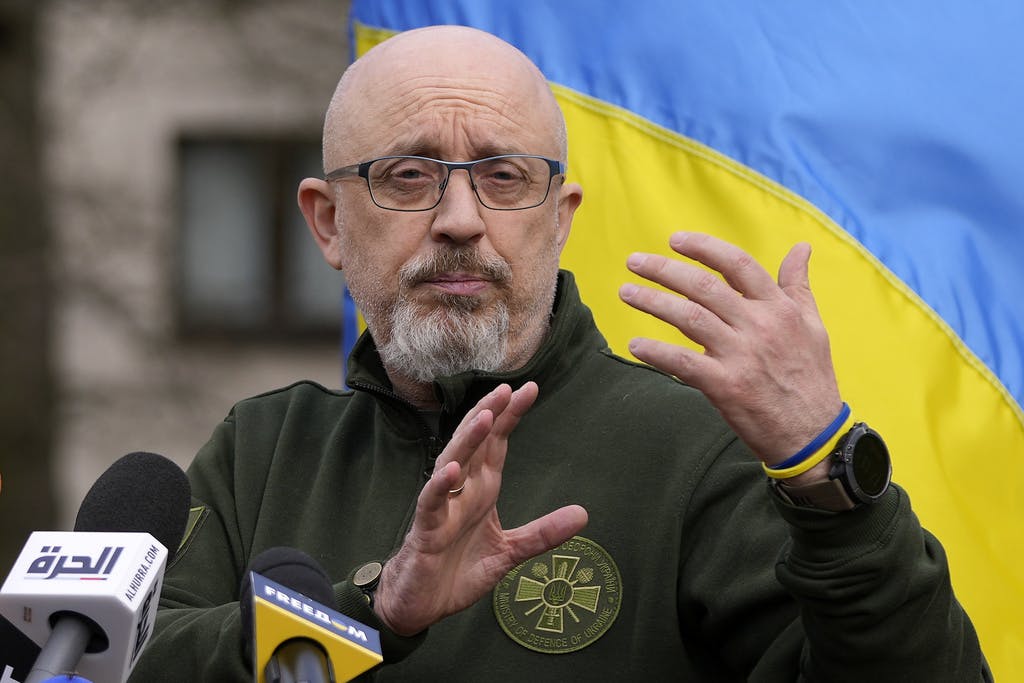Bright Outlook for Ukraine as Military Sheds Soviet Standards in Favor of NATO Doctrines
While Western hesitation slows Kyiv’s ability to deal a final blow to the Russian invader, helping to transform the country’s army to a full NATO-style military may well prove decisive this spring.

“Ukraine belongs in NATO” is the rally cry of supporters of the beleaguered country, but for that ever to happen Kyiv first must defeat Russia. By doing so, it would put on display the advantages of shedding Soviet-like military concepts and replacing them with Western war doctrines.
Comprising more than 50 countries, the Ukraine Defense Contact Group gathered at Germany’s Ramstein base Friday to strategize on the eve of what is shaping up to be a decisive spring. Battles in the eastern and southern parts of the country, where Russian occupation forces are entrenched, could determine victory.
The North Atlantic Treaty Organization’s secretary-general, Jens Stoltenberg, visited Kyiv Thursday, where he announced that Ukraine’s “rightful place is in NATO.” First, he added, it needs to win the war.
To do that, Mr. Stoltenberg said the alliance needs to commit to a “multi-year program to help Ukraine transition from Soviet-era equipment, standards, doctrines, to NATO standards and doctrines, and to ensure full interoperability between Ukrainian forces and NATO forces.”
In reality, that process began a while back. Following the 2014 Russian invasion of Crimea, Kyiv realized it had a problem: “The Ukrainian military was a joke,” an assistant professor of intelligence studies at Mercyhurst University at Erie, Pennsylvania, Fred Hoffman, tells the Sun.
Like other militaries in the former Soviet Union, the Ukrainian army was utterly corrupt. Instead of buying uniforms, higher-ups pilfered the military budgets and “soldiers were going to battle in flip flops,” Mr. Hoffman says. The Russian threat forced the Ukrainians to start rooting out corruption.
American and British military officials, who were similarly alarmed by the Russian threat, started working with the Ukrainians to change military doctrines. The process of transforming from Soviet-style fighting to NATO-like doctrines has been ongoing for nearly a decade now.
Yet, America and other allies have at times disappointed Kyiv by failing to deliver weapons the army says it needs. At times Western politicians urged the Ukrainians to scale back ambitions like full victory — including the retaking of Crimea.
“We’ve heard, ‘No, it’s impossible’ a lot, but I have seen firsthand how the impossible can become possible,” Kyiv’s defense minister, Oleksii Reznikov, told the Ramstein gathering on Friday.
What Ukraine requires now is to “quickly build a multi-level air defense/anti-missile defense system,” he tweeted. “Patriots, IRIS-T, NASAMS, and MiG-29 are the most recent, but not the final, steps towards this goal. Given the Kremlin’s barbaric tactics, we need NATO-style fighter jets.”
Washington and the European capitals have been slow to deliver arms that Kyiv had asked for. American fighter jets would require a lot of training before being put to use, the Pentagon argued at first. Then two Ukrainian pilots arrived in Arizona last month to assess how long it would take to train their country’s air force to operate F-16s, which could replace their Russian-made MiGs.
Over the winter American officials similarly argued that training Ukrainians on Abrams tanks would take too long. German-made Leopards, which more closely resemble Russian-made tanks, would be a better fit for Ukraine, they argued.
Leopards are arriving in Ukraine, and on Friday the American defense secretary, Lloyd Austin, promised that 31 Abrams M1A1 tanks will arrive in Germany in May to train Ukrainians on operation and maintenance methods. The tanks could be deployed in battle much sooner than earlier projected.
While Western hesitation slowed Kyiv’s ability to deal a final blow to the Russian invader, helping to transform the country’s army to a full NATO-style military may well prove decisive this spring.
Transforming Ukraine to democracy is helping that process. Rather than being directed from the capital, as is the case with the Russians, war strategy is led by generals while battle decisions are made by lower-ranked commanders.
The Ukrainian commander in chief, General Valerii Zaluzhnyi, is running the war “like Westmoreland did in Vietnam or Schwartzkopf in Iraq,” Mr. Hoffman, an intelligence community veteran, says. President Putin, in contrast, “can’t do that,” as he is afraid that a victorious general would threaten his hold on power.
Down the ranks Ukrainians now fight with the American concept known as observe, orient, decide, act, referred to as OODA. “Sergeants run the war,” Mr. Hoffman says. While demoralized Russian grunts watch their corrupt generals get drunk, Ukrainian troop commanders make the quick on-the-ground decisions that win battles.
The Ukrainian military has excelled beyond Western expectations and proved essential for European defense. “It is no longer possible to imagine the security of the Euro-Atlantic area without Ukraine, and people understand that,” President Zelensky told the Ramstein gathering on Friday.
Kyiv has undergone a remarkable military transformation. The faster it can translate that metamorphosis into a decisive victory — think the retaking of Crimea — the sooner the war ends. Also, proving that free societies can defeat dictatorships could go a long way toward reasserting America’s global leadership.

